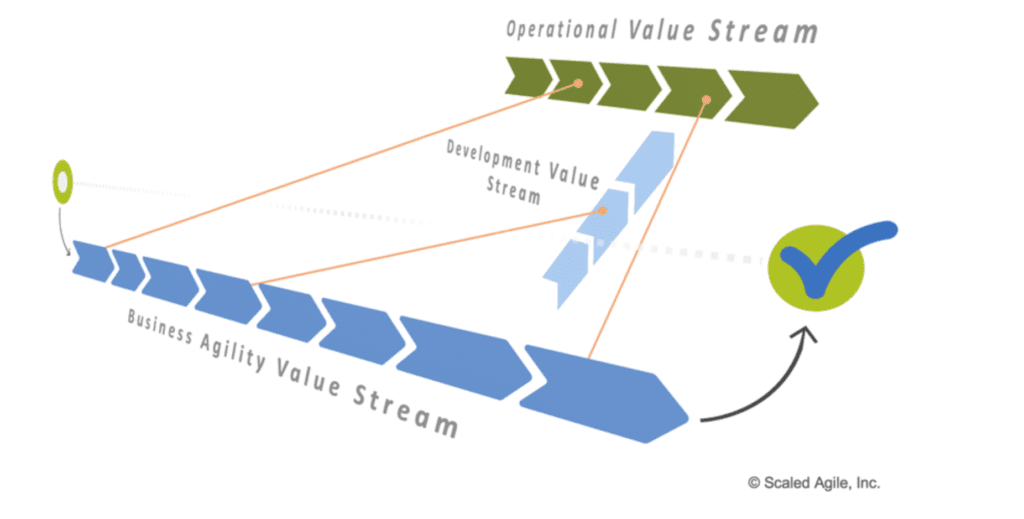If you’ve read the first post in my blog series, you may have been inspired to think about how the emotional intelligence competencies manifest in every step of the business agility value stream. From identifying and sensing the opportunity to learning and adapting to ultimately delivering on the business opportunity. So, if we can measure emotional intelligence competencies, my hypothesis is that they, directly and indirectly, impact flow and outcomes as well.
Let’s go step by step in the business agility value stream and see how applying emotional intelligence directly impacts flow and outcomes.

Sensing the opportunity involves market research, data analysis, customer feedback, and directly observing customers in the marketplace. Applying your own self-regulation, empathy, and social skills can help you have more productive empathy interviews, obtain less-biased, face-to-face research, and control how you react to customer feedback.
This key step in the organizational agility competency involves not only leaders applying ‘go see’, but offering the same ‘go see’ opportunities to other key roles in the development value stream so that they can better understand and reason about the problem to solve. This expands the social networks so that they can apply and evolve their emotional intelligence competencies to effectively communicate, pitch, reason, and articulate effective hypothesis statements that inspire and engage innovation.
Funding the minimum viable product (MVP) requires the motivation and social skills to help drive change, innovate, and communicate intent at scale. We all know this isn’t easy. It requires you to craft the “why” and use your social skills of influence and conflict management to negotiate and secure the funds. Some of the recommendations from the Lean Portfolio Management competency where we can leverage these social skills include:
- Engage in participatory budgeting
- Establish flow and stakeholder engagement through the portfolio Kanban system
- Roadmap the portfolio
- Integrate enterprise architecture and SMEs
- Realize epics
- Establish Lean budgets and guardrails
Organizing around value requires even more of the social skills around communication, building new bonds, and fostering the information coherence necessary to build some of the world’s most complex systems. As well as the ability to connect to the customer so that our people embrace and understand what value they’re trying to deliver.
Team and technical agility and organizational agility not only aid in building these bonds but can leverage and grow all of the emotional intelligence competencies of self-awareness, self-regulation, motivation, empathy, and social skills. This can be amplified with the coveted help from our scrum masters and RTEs.
Connect to the customer leverages our Agile product delivery and enterprise solution competencies and their design thinking skills to listen, reflect, empathize, and connect with the people for whom we’re designing solutions.
This requires going deep into the empathy competency of emotional intelligence by leveraging our service-orientation mindset so that we can foresee, recognize, and meet customer needs. Diversity is also important for the ongoing development of opportunities and awareness in all societies and social circles. If we can evolve the empathy competency in all aspects of product and solution delivery, we have the opportunity to excel beyond our competitors in delivering value.
Delivering that MVP calls upon our product and solution delivery folks to lead, and our social networks to collaborate, iterate, communicate, and deliver using their motivation and social skills. It also pulls highly on our social networks to have courage, collaborate and cooperate, take risks, and instrument rapid change so that we can learn and adapt to our ever-changing market landscapes.
Pivot or persevere pulls on the need for empathy when things don’t turn out as desired and the time comes to pivot or persevere. Our Lean portfolio management fiduciaries reason about the data, facts, and outcomes of the MVP and could quite possibly pivot to a direction of a higher cost of delay at any moment. This means we need to abandon our emotional attachment to what we created and turn to the next-highest value delivery. Self-regulation and empathy both play strongly in this step of the business agility value stream. Having the emotional awareness of why our folks are for or against any change in this step can help mitigate any delays in fostering rapid change and learning.
Deliver value continuously imposes that our product and solution delivery people and ARTs always work together to share knowledge, build out that continuous delivery pipeline, and innovate. The continuous delivery pipeline and our DevOps mindset enable that fast-feedback loop to foster our continuous learning culture. Our iterative and incremental heartbeat also facilitates that continuous value delivery and learning cycle. All require using our social skills to grow and enable knowledge transfer and information coherence so that the social network can continue to thrive and innovate.
Our learn and adapt cycle is integral to the process, Measuring our emotional intelligence competencies will help us learn and grow our own selves alongside the SAFe core competencies. After all, if we don’t learn about ourselves, how can we show up with our truest authenticity to grow and foster that continuous learning culture?
Lean-Agile leadership enables the business agility value stream, as does the evolution of everyone’s emotional intelligence. Leaders model and leverage all of the emotional intelligence competencies so that our development value streams can evolve both their business agility competencies and their emotional competencies. If we don’t consider human emotion, we can inhibit flow, people shut down and lose their motivation, and thus jeopardize providing value to our customers.

Now, if the business agility value stream is a perspective across operational and development value streams, then the benefits, interactions, and human impacts that the emotional intelligence of the development value stream network provides to the operational value stream will propagate and evolve. The interactions and modeling of emotional intelligence will have a bi-directional impact that will engage and accelerate the operational value stream in delivering value.
I hope I’ve provided a perspective that it’s not just mastering the SAFe business agility process competencies that enable business agility. The evolution of human emotional intelligence impacts the flow and outcomes of the business agility value stream every step of the way. As I mentioned in part 1 of this blog series, Goleman’s personal competencies of self-awareness, self-regulation, and motivation fuel our human agency and our ability to manage our own emotions. The social competencies of empathy and social skills fuel how we handle relationships. Together, the evolution of emotional intelligence within our organization increases our ability to deliver value to our customers, as well as value to our individual people. What enterprise doesn’t want that?
At this point, you may be asking, “Well, how can I bring these into my SAFe transformation and journey toward business agility?”
Here are a few techniques to get you started on your emotional intelligence journey:
- Start with you. Allow time for self-reflection, self-work, and to recharge yourself. Leverage your retrospectives, your own personal plan-do-check-adjust cycles, and the teaming activities to evolve your emotional intelligence competencies. Integrate some emotional intelligence workshops with your leaders and teams to help evolve and experience the competencies, starting with self-awareness and self-regulation. This will help build trust so you can continue to unfold into the deeper and perhaps more sensitive competencies of empathy and social skills.
- Grow your own internal and external coaching network. In the same way that sports teams need coaches, our operational and development value streams and the individuals within them need coaches too. They help with all aspects of emotional intelligence, wherever folks may need or want assistance. They can provide the tools and techniques to become more self-aware, provide exercises for self-regulation and motivation, and practice empathy. Not to mention offer assistance to help people evolve their social skills. And even more powerful, coaches model the behaviors so that our social networks can lean into what they see and learn.
- Create a community of practice around the competencies and practices. In the latest Leading by Example module that Scaled Agile released, one of the beautiful outcomes was a cohort that trusted each other and was willing to share their deepest challenges with authenticity. This type of network provides the power of a safe space that people can always come back to, to practice, share ideas and concerns, and grow without judgement or fear.
- Help evolve assessments around Goleman’s Emotional Intelligence Competency Framework. And measure the evolution within your people and the enterprise. You’ll start to see some correlations between the SAFe measurements of flow, competencies, and outcomes.
- Share with our community. We’d love to hear how evolving your enterprise intelligence will help your employees achieve their aspirations and help customers receive better products and solutions.
And, reach out to me. I’d love to hear how it’s going so I can learn and grow with you! I may not have been born with emotional intelligence but I’m passionate about learning and evolving with you. Find me on LinkedIn.
About Jennifer Fawcett

Jennifer is a retired, empathetic Lean and Agile leader, practitioner, coach, speaker, and consultant. A SAFe® Fellow, she has contributed to and helped develop SAFe content and courseware. Her passion and focus have been in delivering value in the workplace and by creating communities and culture through effective product management, product ownership, executive portfolio coaching, and leadership. She has provided dedicated service in these areas to technology companies for over 35 years. Connect with Jennifer on LinkedIn.
Share:
Back to: All Blog Posts
Next: Aligning Global Teams Through Agile Program Management: A Case Study